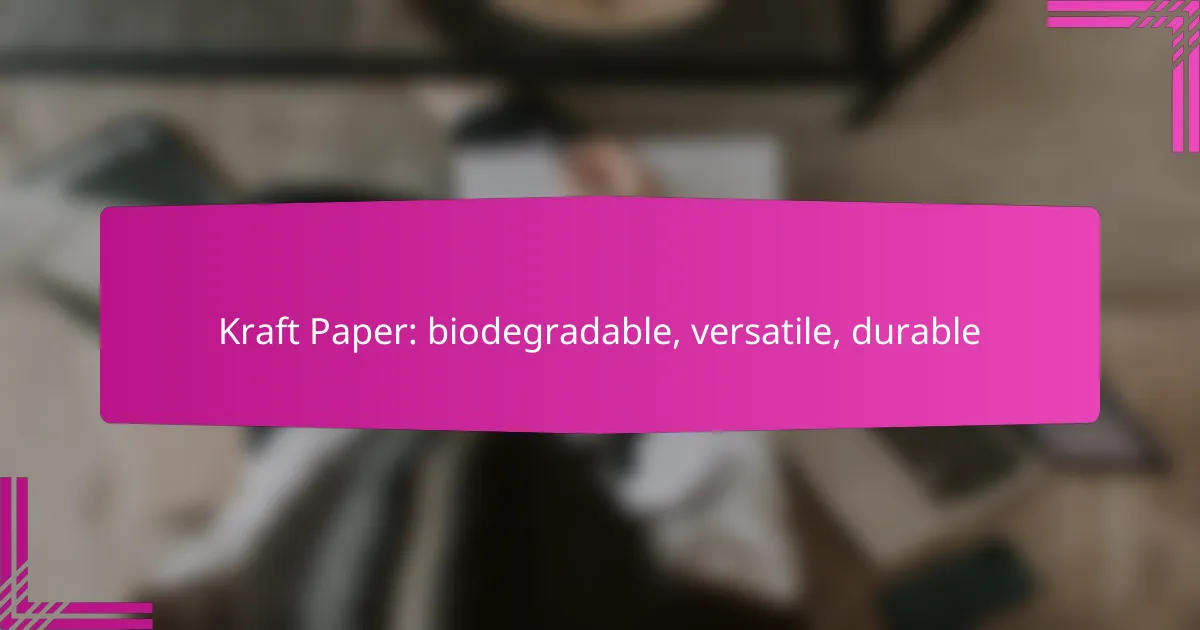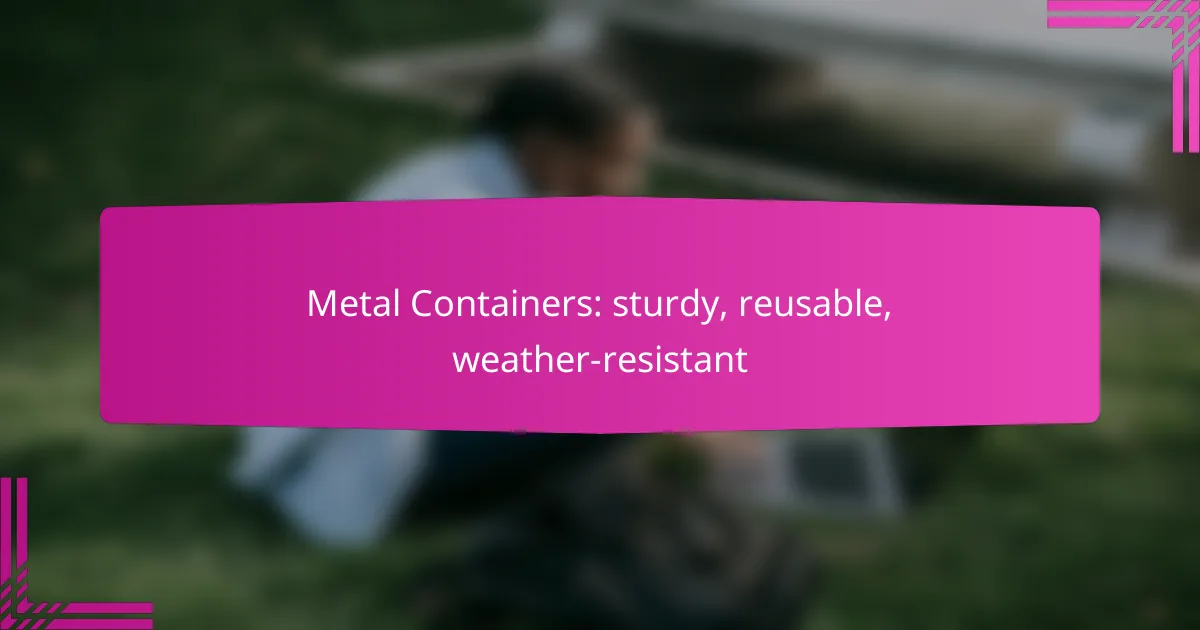Kraft paper is an eco-friendly material made from natural fibers, making it biodegradable and suitable for sustainable practices. Its versatility allows it to be used across various industries, while its durability ensures it can withstand a range of applications effectively. With a strong construction derived from high-quality wood pulp, kraft paper combines environmental responsibility with practical functionality.

How is Kraft paper biodegradable in New Zealand?
Kraft paper is biodegradable in New Zealand due to its composition from natural fibers, which break down easily in the environment. This process is facilitated by the country’s favorable composting conditions and regulations that support sustainable waste management practices.
Made from renewable resources
Kraft paper is produced from wood pulp, primarily sourced from sustainably managed forests. This renewable resource ensures that the production of Kraft paper has a lower environmental impact compared to papers made from non-renewable materials. Additionally, many manufacturers in New Zealand adhere to certification standards, such as FSC (Forest Stewardship Council), which promotes responsible forestry practices.
Composts within months
In New Zealand, Kraft paper can decompose in composting environments within a few months, depending on conditions like moisture and temperature. This rapid breakdown is advantageous for reducing landfill waste and contributing to soil health. To ensure effective composting, it is recommended to shred the paper into smaller pieces and mix it with green materials, such as food scraps or yard waste.

What are the versatile uses of Kraft paper?
Kraft paper is widely recognized for its versatility, making it suitable for various applications across different industries. Its biodegradable nature, combined with durability, allows it to serve multiple purposes effectively.
Packaging materials
Kraft paper is commonly used in packaging due to its strength and eco-friendliness. It is ideal for making bags, boxes, and wrapping materials that can hold a variety of products, from food items to retail goods. Many businesses prefer Kraft paper packaging as it is recyclable and biodegradable, aligning with sustainable practices.
When selecting Kraft paper for packaging, consider the weight and thickness. For heavier items, opt for thicker grades, while lighter grades work well for smaller products. Additionally, printed Kraft paper can enhance branding while maintaining an organic look.
Arts and crafts
Kraft paper is a favorite among artists and crafters for its natural texture and versatility. It can be used for drawing, painting, scrapbooking, and various DIY projects. Its ability to absorb ink and paint makes it suitable for a range of artistic techniques.
For crafting, consider using Kraft paper for making cards, gift wraps, or decorative elements. Its neutral color allows for easy customization with paints, stamps, or other embellishments. Additionally, it can be easily cut, folded, and glued, making it accessible for all skill levels.
Stationery products
Kraft paper is increasingly popular in the stationery market, offering a rustic yet modern aesthetic. It is commonly used for notebooks, journals, and envelopes, appealing to consumers looking for eco-friendly options. The durability of Kraft paper ensures that these products can withstand daily use.
When choosing Kraft paper for stationery, look for options that are acid-free to prevent yellowing over time. Customization options, such as embossing or printing, can enhance the appeal of Kraft stationery products, making them suitable for personal or professional use.
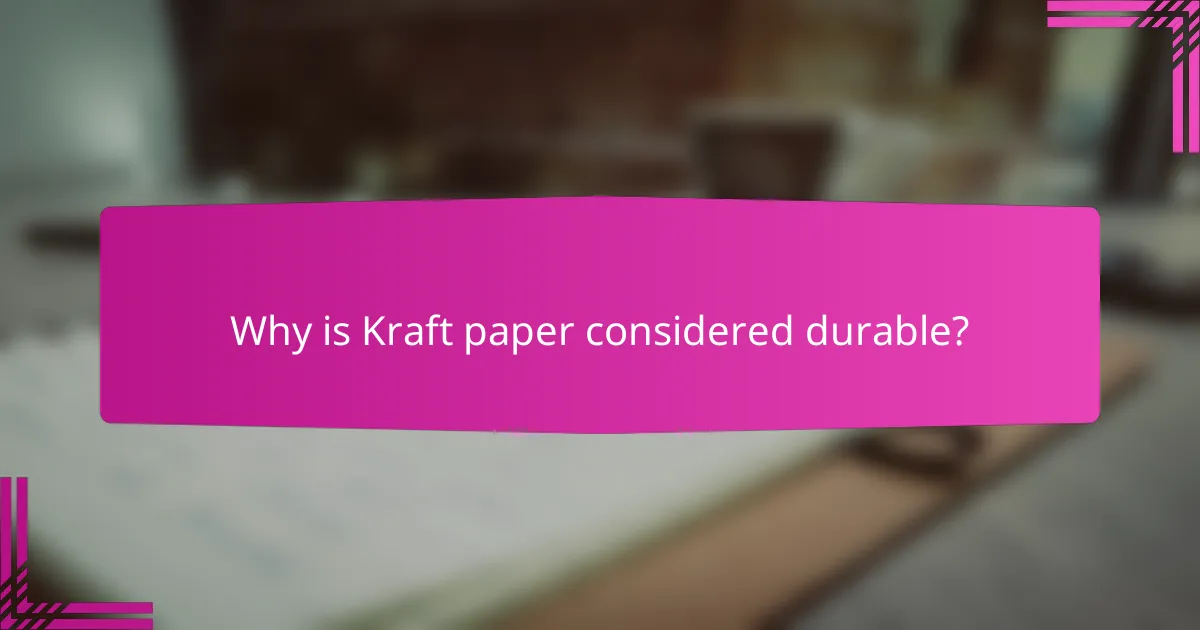
Why is Kraft paper considered durable?
Kraft paper is considered durable due to its robust construction and inherent properties that enhance its strength and resilience. Its manufacturing process, which involves the use of high-quality wood pulp, contributes to its ability to withstand various stresses and strains.
High tensile strength
Kraft paper exhibits high tensile strength, meaning it can endure significant pulling forces without breaking. This characteristic makes it suitable for applications such as packaging heavy items, where other types of paper may fail. The tensile strength of Kraft paper typically ranges from 30 to 50 grams per square meter (gsm), depending on its thickness and grade.
When selecting Kraft paper for specific uses, consider the weight and type of items being packaged. Thicker grades provide enhanced strength, making them ideal for shipping and industrial applications.
Resistant to tearing
One of the standout features of Kraft paper is its resistance to tearing, which is crucial for maintaining the integrity of packages during handling and transport. This resistance is attributed to the fiber structure of the paper, which allows it to absorb shocks and resist damage from sharp objects.
For practical use, choosing a higher grammage Kraft paper can further improve tear resistance. This is especially important for products that may be subjected to rough handling, ensuring that the packaging remains intact and protects the contents effectively.
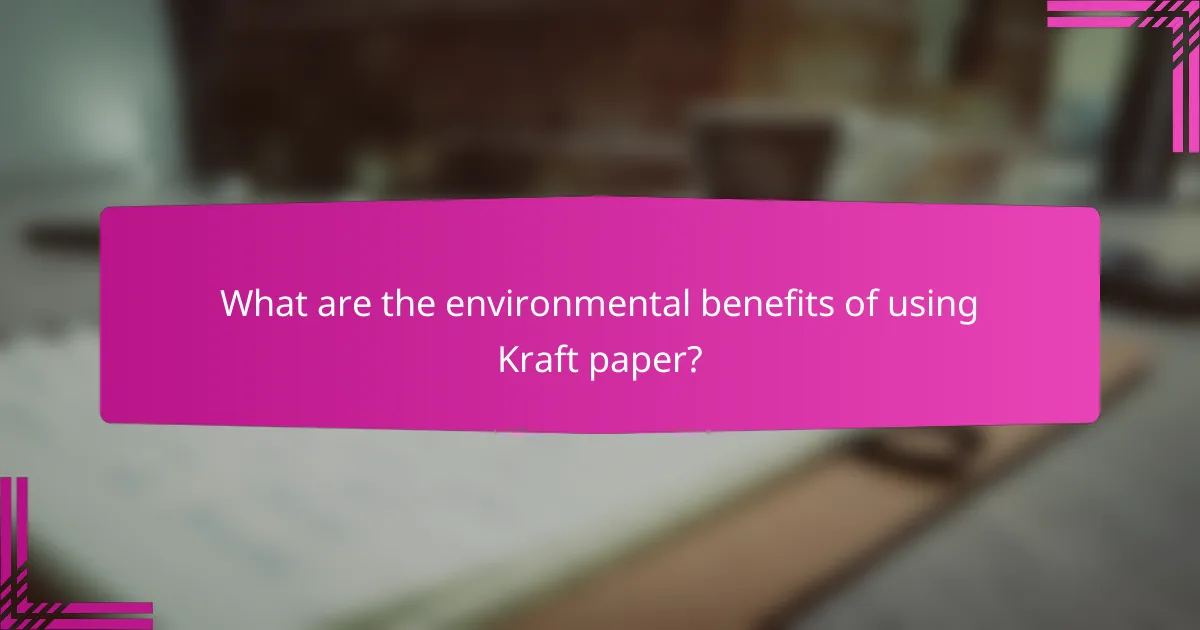
What are the environmental benefits of using Kraft paper?
Kraft paper offers significant environmental benefits, primarily due to its biodegradability, versatility, and durability. By opting for Kraft paper products, consumers can contribute to reducing pollution and promoting sustainable practices.
Reduces plastic waste
Kraft paper serves as an effective alternative to plastic packaging, helping to minimize plastic waste in landfills and oceans. Unlike plastic, which can take hundreds of years to decompose, Kraft paper breaks down naturally within a few months, reducing long-term environmental impact.
Using Kraft paper for bags, wraps, and packaging can significantly lower the demand for single-use plastics. For instance, switching from plastic bags to Kraft paper bags can help reduce the volume of plastic waste generated in daily shopping activities.
Supports sustainable forestry
Kraft paper is typically produced from wood pulp sourced from sustainably managed forests, which helps maintain ecological balance. This process often adheres to strict regulations that promote reforestation and responsible logging practices, ensuring that forest ecosystems remain healthy.
By choosing Kraft paper products, consumers can support companies that prioritize sustainable forestry practices. Many brands now carry certifications, such as FSC (Forest Stewardship Council), indicating their commitment to environmentally friendly sourcing.

How to choose the right Kraft paper for your needs?
Choosing the right Kraft paper involves considering its weight, thickness, and surface finish to match your specific requirements. Understanding these factors will help you select a product that is both functional and suitable for your intended use.
Consider weight and thickness
The weight and thickness of Kraft paper are crucial for determining its strength and durability. Common weights range from 30 to 100 grams per square meter (gsm), with heavier options providing more robustness for packaging and crafts.
For lightweight applications like wrapping delicate items, a lower gsm is sufficient. Conversely, for tasks requiring more durability, such as shipping or industrial uses, opt for thicker, heavier paper. Always check the specifications to ensure it meets your needs.
Evaluate surface finish
The surface finish of Kraft paper affects its appearance and functionality. Options include smooth, textured, or coated finishes, each serving different purposes. A smooth finish is ideal for printing, while a textured surface can enhance the aesthetic appeal for crafts.
When selecting a finish, consider the end use. For example, if you need Kraft paper for food packaging, ensure it meets relevant food safety standards. Additionally, coated papers may offer better moisture resistance, making them suitable for outdoor applications.

What are the cost factors for Kraft paper in New Zealand?
The cost of Kraft paper in New Zealand is influenced by several factors, including bulk purchase discounts, shipping costs, and market demand. Understanding these elements can help businesses and consumers make informed purchasing decisions.
Bulk purchase discounts
Bulk purchase discounts are a significant factor in the overall cost of Kraft paper. Many suppliers offer reduced rates for larger orders, which can lead to savings of 10-30% compared to buying smaller quantities. Businesses that regularly use Kraft paper should consider purchasing in bulk to take advantage of these discounts.
When negotiating bulk orders, it’s essential to compare prices from different suppliers and inquire about minimum order quantities. This can help ensure that you secure the best deal while meeting your supply needs.
Shipping costs
Shipping costs can greatly impact the final price of Kraft paper in New Zealand. Factors such as distance from the supplier, order size, and shipping method all play a role in determining these expenses. Generally, larger orders may qualify for lower per-unit shipping rates, making them more cost-effective.
To minimize shipping costs, consider local suppliers or those with distribution centers closer to your location. Additionally, consolidating orders or coordinating with other businesses for shared shipments can further reduce transportation expenses.
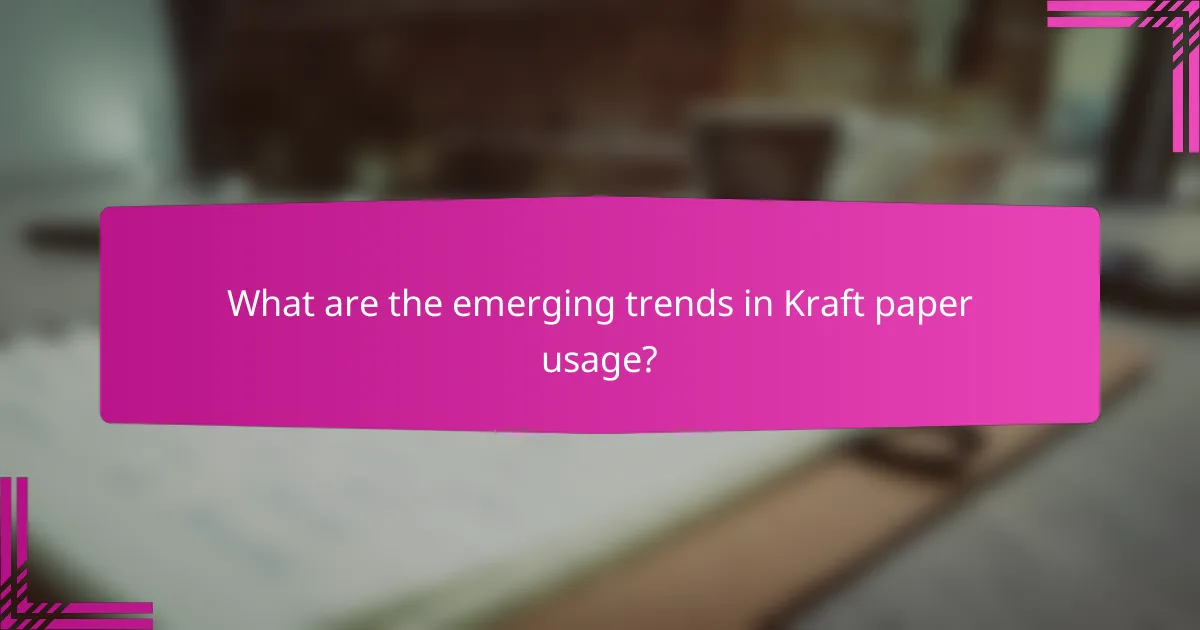
What are the emerging trends in Kraft paper usage?
Emerging trends in Kraft paper usage highlight its growing popularity due to its biodegradable nature, versatility, and durability. Industries are increasingly adopting Kraft paper as a sustainable alternative to plastic and other non-biodegradable materials.
Increased demand for sustainable packaging
There is a notable shift towards sustainable packaging solutions, with Kraft paper leading the way. Many companies are opting for Kraft paper to reduce their environmental footprint, as it is recyclable and compostable. This trend is particularly strong in the food and retail sectors, where consumers prefer eco-friendly options.
Innovations in design and functionality
Innovations in Kraft paper have enhanced its design and functionality, making it suitable for a wider range of applications. Manufacturers are developing water-resistant and tear-resistant variants, which maintain the paper’s biodegradable properties while offering improved durability. These advancements allow Kraft paper to be used in packaging, bags, and even as a protective layer in shipping.
Regulatory support for eco-friendly materials
Governments worldwide are implementing regulations that encourage the use of eco-friendly materials, including Kraft paper. For instance, some regions are introducing bans on single-use plastics, prompting businesses to seek sustainable alternatives. This regulatory support is expected to further boost the adoption of Kraft paper across various industries.
